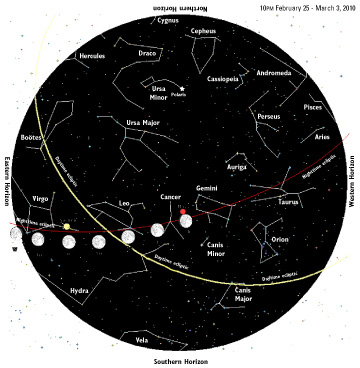Chesapeake Bay's Independent Newspaper ~ Since 1993
1629 Forest Drive, Annapolis, MD 21403 ~ 410-626-9888
Volume xviii, Issue 8 ~ February 25 - March 3, 2010
Home \\ Correspondence \\ from the Editor \\ Submit a Letter \\ Classifieds \\ Contact Us
Best of the Bay \\ Dining Guide \\ Home & Garden Guide \\ Archives \\ Distribution \\ Advertising![]()


Sky Watch

by J. Alex Knoll
The Many Paths of the Sun
They’re all a result of earth’s 231⁄2-degree tilt
Driving across the Naval Academy Bridge on a recent balmy day, I noticed that along one side of the bridge the snow was well melted, while on the other side it was still mounded high. This wasn’t the work of some errant snowplow driver, I realized, but rather the result of earth’s 231⁄2-degree tilted axis and the ecliptic, the imaginary celestial line on which the planets, moon and sun appear to travel.
Just a few weeks past the mid-point of winter, the daytime ecliptic for us in the Northern Hemisphere is still quite low, with the sun less than 45 degrees above the horizon at its noon-time zenith. At winter solstice, the daytime ecliptic was its most shallow, with the sun rising and setting at its most southern point while peaking peak at a mere 27 degrees above the horizon. As we near spring equinox, the points of sunrise and sunset draw ever nearer to due east and due west. Come summer solstice, the path of the sun is its most steep, rising well north of east, peaking 75 degrees above the horizon and setting far north of west.
All these lines and angles are a result of the 231⁄2-degree tilted axis on which earth spins — or rather wobbles. Without this wobble, the path of the sun, moon and planets would never change, nor would our seasons.
So even though the temperature that day cracked the 50-degree mark, the sun didn’t climb high enough for its rays to hit the eastern side, casting it in shadow all day long while the western side melted in the warmth. This play of light and dark is a microcosm of our own seasons. The winter sun never climbs high enough to bathe us in its warming glow. Conversely, the higher the ecliptic, the more the sun’s rays strike us head-on. Additionally, the higher the sun peaks, the more time between sunrise and sunset, and thus more hours to warm us.
Illustration: © Copyright 1925 M.C. Escher/Cordon Art-Baarn-Holland; Graphics: © Copyright 2010 Pacific Publishers. Reprinted by permission from the Tidelog graphic almanac. Bound copies of the annual Tidelog for Chesapeake Bay are $14.95 ppd. from Pacific Publishers, Box 480, Bolinas, CA 94924. Phone 415-868-2909. Weather affects tides. This information is believed to be reliable but no guarantee of accuracy is made by Bay Weekly or Pacific Publishers. The actual layout of Tidelog differs from that used in Bay Weekly. Tidelog graphics are repositioned to reflect Bay Weekly’s distribution cycle.Tides are based on National Oceanic and Atmospheric Administration and are positioned to coincide with high and low tides of Tidelog.
© COPYRIGHT 2010 by New Bay Enterprises, Inc. All rights reserved.
